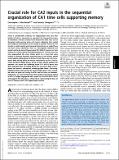Notice
This is not the latest version of this item. The latest version can be found at:https://dspace.mit.edu/handle/1721.1/133984.2
Crucial role for CA2 inputs in the sequential organization of CA1 time cells supporting memory
| dc.contributor.author | MacDonald, Christopher J | |
| dc.contributor.author | Tonegawa, Susumu | |
| dc.date.accessioned | 2021-10-27T19:57:30Z | |
| dc.date.available | 2021-10-27T19:57:30Z | |
| dc.date.issued | 2021 | |
| dc.identifier.uri | https://hdl.handle.net/1721.1/133984 | |
| dc.description.abstract | © 2021 National Academy of Sciences. All rights reserved. There is considerable evidence for hippocampal time cells that briefly activate in succession to represent the temporal structure of memories. Previous studies have shown that time cells can be disrupted while leaving place cells intact, indicating that spatial and temporal information can be coded in parallel. However, the circuits in which spatial and temporal information are coded have not been clearly identified. Here we investigated temporal and spatial coding by dorsal hippocampal CA1 (dCA1) neurons in mice trained on a classic spatial working-memory task. On each trial, the mice approached the same choice point on a maze but were trained to alternate between traversing one of two distinct spatial routes (spatial coding phase). In between trials, there was a 10-s mnemonic delay during which the mouse continuously ran in a fixed location (temporal coding phase). Using cell-type–specific optogenetic methods, we found that inhibiting dorsal CA2 (dCA2) inputs into dCA1 degraded time cell coding during the mnemonic delay and impaired the mouse’s subsequent memory-guided choice. Conversely, inhibiting dCA2 inputs during the spatial coding phase had a negligible effect on place cell activity in dCA1 and no effect on behavior. Collectively, our work demonstrates that spatial and temporal coding in dCA1 is largely segregated with respect to the dCA2–dCA1 circuit and suggests that CA2 plays a critical role in representing the flow of time in memory within the hippocampal network. | |
| dc.language.iso | en | |
| dc.publisher | Proceedings of the National Academy of Sciences | |
| dc.relation.isversionof | 10.1073/pnas.2020698118 | |
| dc.rights | Article is made available in accordance with the publisher's policy and may be subject to US copyright law. Please refer to the publisher's site for terms of use. | |
| dc.source | PNAS | |
| dc.title | Crucial role for CA2 inputs in the sequential organization of CA1 time cells supporting memory | |
| dc.type | Article | |
| dc.relation.journal | Proceedings of the National Academy of Sciences of the United States of America | |
| dc.eprint.version | Final published version | |
| dc.type.uri | http://purl.org/eprint/type/JournalArticle | |
| eprint.status | http://purl.org/eprint/status/PeerReviewed | |
| dc.date.updated | 2021-08-03T15:35:24Z | |
| dspace.orderedauthors | MacDonald, CJ; Tonegawa, S | |
| dspace.date.submission | 2021-08-03T15:35:25Z | |
| mit.journal.volume | 118 | |
| mit.journal.issue | 3 | |
| mit.license | PUBLISHER_POLICY | |
| mit.metadata.status | Authority Work and Publication Information Needed |
